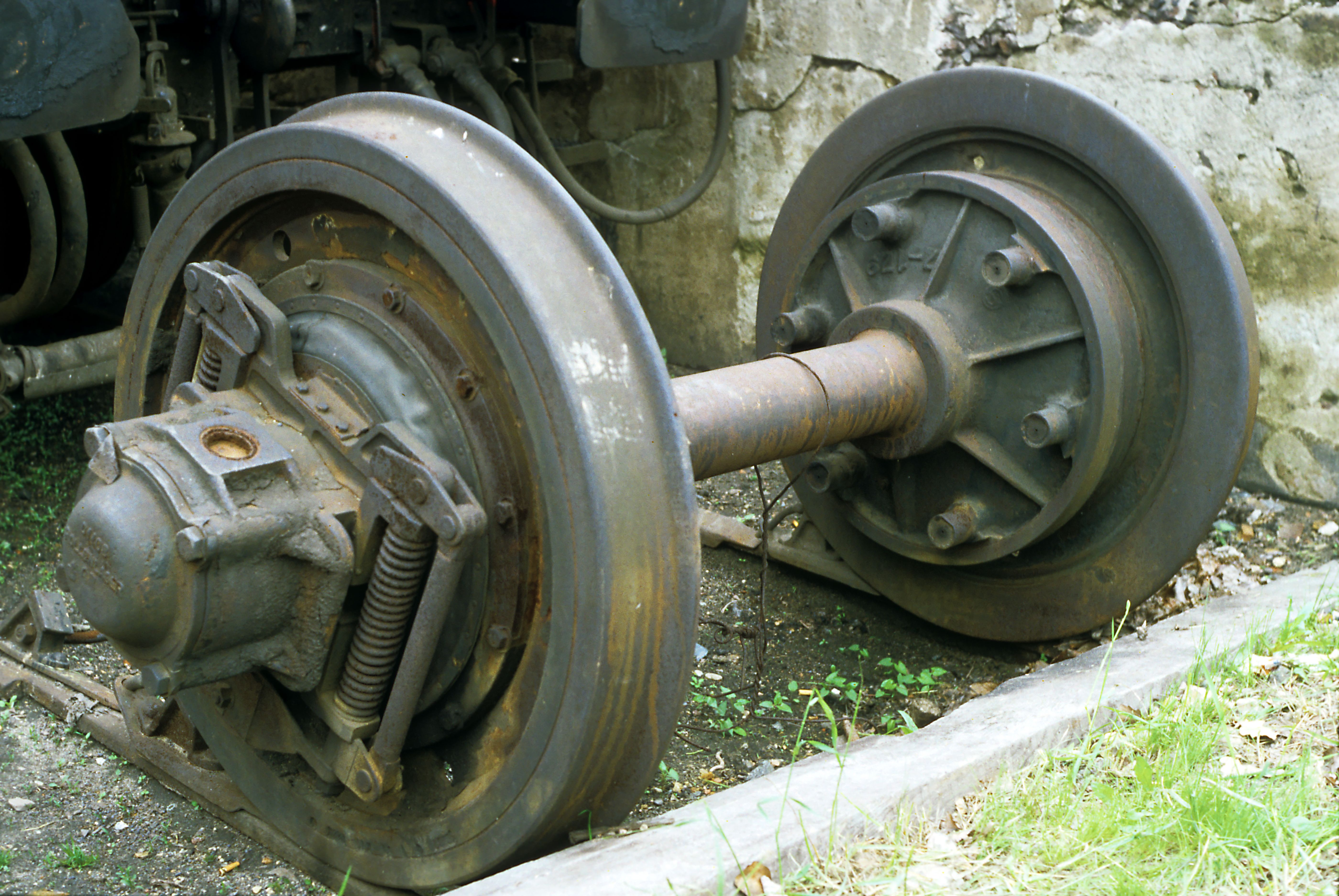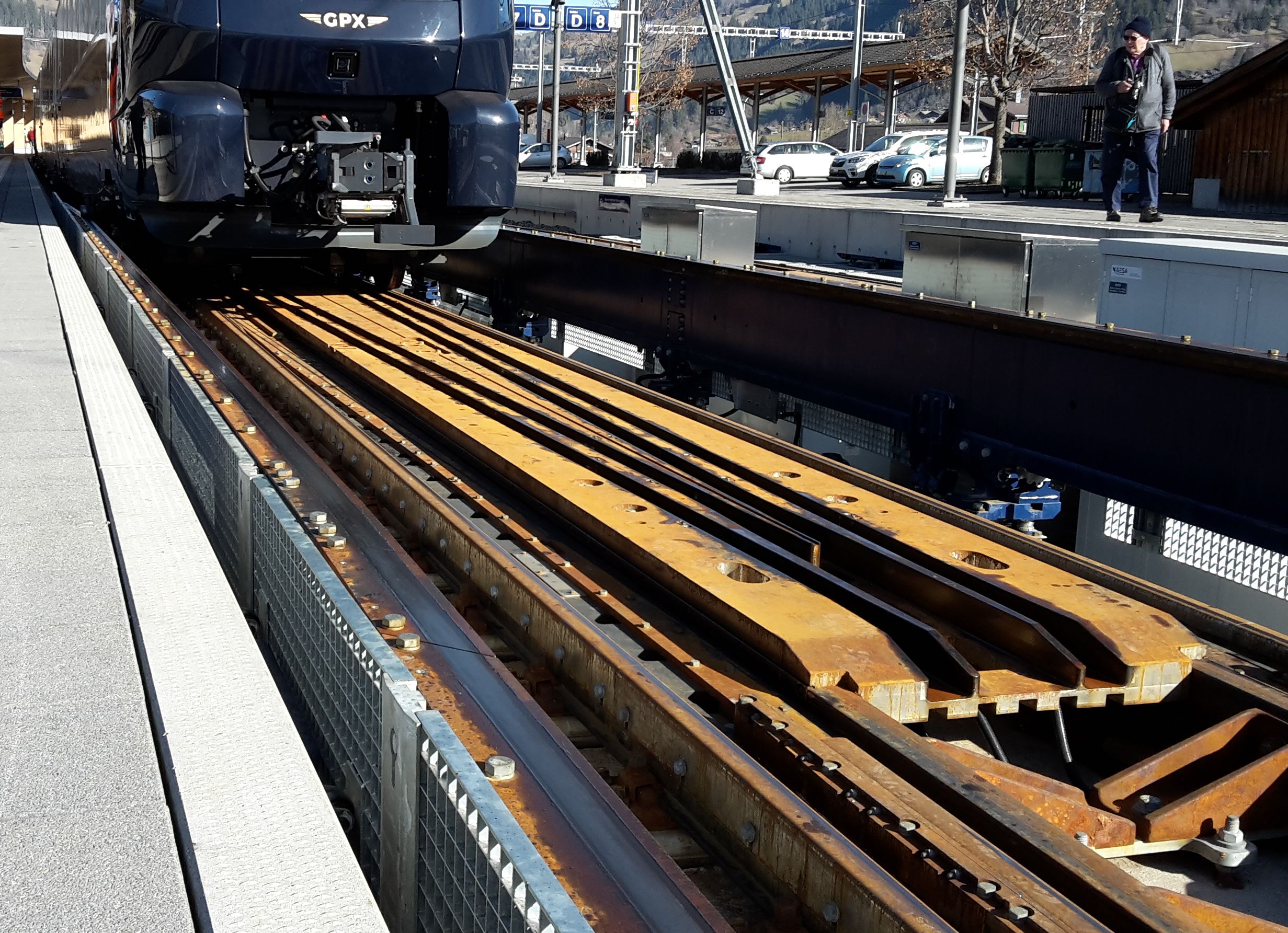|
Mostyska II
Mostyska II () is a railway station in the village Mostyska Druhi, Yavoriv Raion in Lviv Oblast of Ukraine. It is part of the Lviv administration (Lviv Railways). The station is located on the historical Galician Railway of Archduke Charles Louis linking Kraków with Lviv through Przemyśl. It was built in 1950 just outside the town of Mostyska, whose station has been renamed to Mostyska I, away from Medyka rail station in Medyka, Poland. Today it constitutes an important transportation gateway between Ukraine and the rest of Europe on the Pan-European Corridor III. There is a break of gauge where the railway systems of the two countries meet, as the Ukrainian part of the route was converted to Russian broad gauge during Soviet rule. To speed up though traffic, a track gauge changing facility of the SUW 2000 variable gauge axle system has been installed to allow fitted trains to pass through the break of gauge at walking pace. See also * Poland-Ukraine border References Exter ... [...More Info...] [...Related Items...] OR: [Wikipedia] [Google] [Baidu] |
Railway Terminal Mostyska II
Rail transport (also known as train transport) is a means of transport using wheeled vehicles running in railway track, tracks, which usually consist of two parallel steel railway track, rails. Rail transport is one of the two primary means of land transport, next to road transport. It is used for about 8% of passenger and rail freight transport, freight transport globally, thanks to its Energy efficiency in transport, energy efficiency and potentially high-speed rail, high speed.Rolling stock on rails generally encounters lower friction, frictional resistance than rubber-tyred road vehicles, allowing rail cars to be coupled into longer trains. Power is usually provided by Diesel locomotive, diesel or Electric locomotive, electric locomotives. While railway transport is capital intensity, capital-intensive and less flexible than road transport, it can carry heavy loads of passengers and cargo with greater energy efficiency and safety. Precursors of railways driven by human or an ... [...More Info...] [...Related Items...] OR: [Wikipedia] [Google] [Baidu] |
Pan-European Corridor III
The Corridor IIІ is one of the Pan-European corridors. The corridor follows the route: Dresden - Wrocław - Katowice - Kraków - Lviv - Kyiv Branches * Branch A - Berlin - Wrocław The Road corridor Approximately 1650 km, commencing from Dresden, Germany, as a continuation of European Route E40 Calais - Brussels - Aachen - Cologne Cologne ( ; ; ) is the largest city of the States of Germany, German state of North Rhine-Westphalia and the List of cities in Germany by population, fourth-most populous city of Germany with nearly 1.1 million inhabitants in the city pr ..., and continues as E40 through southern Poland to Kyiv, Ukraine, where E40 continues through Russia, Kazakhstan, Uzbekistan, Turkmenistan, and Kyrgyzstan to Ridder in Kazakhstan . Germany The Southern Branch from Dresden 97 km as A4 (E40) as four-lane Autobahn with hard shoulder and the tunnel “ Königshainer Berge” east to Poland at Ludwigsdorf. Poland National Road DK 4 (1996) as A4 moto ... [...More Info...] [...Related Items...] OR: [Wikipedia] [Google] [Baidu] |
Lviv Railways Stations
Lviv ( or ; ; ; see #Names and symbols, below for other names) is the largest city in western Ukraine, as well as the List of cities in Ukraine, fifth-largest city in Ukraine, with a population of It serves as the administrative centre of Lviv Oblast and Lviv Raion, and is one of the main Ukrainian culture, cultural centres of Ukraine. Lviv also hosts the administration of Lviv urban hromada. It was named after Leo I of Galicia, the eldest son of Daniel of Galicia, Daniel, King of Ruthenia. Lviv (then Lwów) emerged as the centre of the historical regions of Red Ruthenia and Galicia (Eastern Europe), Galicia in the 14th century, superseding Halych, Chełm, Belz, and Przemyśl. It was the capital of the Kingdom of Galicia–Volhynia from 1272 to 1349, when it went to King Casimir III the Great of Kingdom of Poland, Poland in a Galicia–Volhynia Wars, war of succession. In 1356, Casimir the Great granted it town rights. From 1434, it was the regional capital of the Ruthenian ... [...More Info...] [...Related Items...] OR: [Wikipedia] [Google] [Baidu] |
1950 Establishments In The Soviet Union
Year 195 (Roman numerals, CXCV) was a common year starting on Wednesday of the Julian calendar. At the time, it was known in Rome as the Year of the Consulship of Scrapula and Clemens (or, less frequently, year 948 ''Ab urbe condita''). The denomination 195 for this year has been used since the early medieval period, when the Anno Domini calendar era became the prevalent method in Europe for naming years. Events By place Roman Empire * Emperor Septimius Severus has the Roman Senate deify the previous emperor Commodus, in an attempt to gain favor with the family of Marcus Aurelius. * King Vologases V of Parthia, Vologases V and other eastern princes support the claims of Pescennius Niger. The Roman province of Mesopotamia (Roman province), Mesopotamia rises in revolt with Parthian support. Severus marches to Mesopotamia to battle the Parthians. * The Roman province of Syria is divided and the role of Antioch is diminished. The Romans annex the Syrian cities of Edessa, Mes ... [...More Info...] [...Related Items...] OR: [Wikipedia] [Google] [Baidu] |
Variable Gauge Axle
Variable gauge systems allow railway vehicles to travel between two railways with different track gauges. Vehicles are equipped with variable gauge axles (VGA). The gauge is altered by driving the train through a gauge changer installed at the break of gauge which moves the wheels to the gauge desired. Variable gauge systems exist within the internal network of Spain, and are installed on international links between Spain/France (Spanish train), Sweden/Finland (Swedish train), Poland/Lithuania (Polish train) and Poland/Ukraine (Polish train). A system for changing gauge without the need to stop is in widespread use for passenger traffic in Spain, for services run on a mix of dedicated high-speed lines (using Standard gauge) and older lines (using Iberian gauge). Similar systems for freight traffic are still in their infancy, as the higher axle weight increases the technological challenge. Although several alternatives exist, including transferring freight, replacing individual ... [...More Info...] [...Related Items...] OR: [Wikipedia] [Google] [Baidu] |
SUW 2000
SUW 2000 is a Polish variable gauge system that allows trains to cross a break of gauge. It is interoperable with the German Rafil Type V system (built by the Radsatzfabrik Ilsenburg). History The SUW 2000 system was designed by Ryszard Suwalski. Suwalski, of PKP Cargo, developed the system between 1990 and 1992. Prototype wheelsets, bogies for passenger carriages and goods wagons, and gauge changer were produced in 1993. The wheelsets were manufactured by ZNTK Poznań. In October 2000 first regular passenger and freight trains started running between Poland and Lithuania. In June 2003 regular passenger trains started running between Poland and Ukraine. In 2008 SUW 2000 II, a development of the original SUW 2000, was presented. It introduced new bogie, improved gauge changer that is expected to last 20% longer, and electronic system checking and registering regauging and wheelset locking. In 2019, as the result of the bankruptcy and subsequent liquidation of ZNTK Poznań, PKP ac ... [...More Info...] [...Related Items...] OR: [Wikipedia] [Google] [Baidu] |
Track Gauge Changing Facility
Variable gauge systems allow railway vehicles to travel between two railways with different track gauges. Vehicles are equipped with variable gauge axles (VGA). The gauge is altered by driving the train through a gauge changer installed at the break of gauge which moves the wheels to the gauge desired. Variable gauge systems exist within the internal network of Spain, and are installed on international links between Spain/France (Spanish train), Sweden/Finland (Swedish train), Poland/Lithuania (Polish train) and Poland/Ukraine (Polish train). A system for changing gauge without the need to stop is in widespread use for passenger traffic in Spain, for services run on a mix of dedicated high-speed lines (using Standard gauge) and older lines (using Iberian gauge). Similar systems for freight traffic are still in their infancy, as the higher axle weight increases the technological challenge. Although several alternatives exist, including transferring freight, replacing individual ... [...More Info...] [...Related Items...] OR: [Wikipedia] [Google] [Baidu] |
Russian Broad Gauge
Railways with a railway track gauge of first appeared in the United Kingdom and the United States. This gauge became commonly known as "Russian gauge", because the government of the Russian Empire chose it in 1843. Former areas and states (such as Finland) of the Empire have inherited this standard. However in 1970, Soviet Railways re-defined the gauge as 1,520 mm (). With about of track, 1,520 mm is the second-most common gauge in the world, after . History Great Britain, 1748 In 1748, the Wylam waggonway was built to a gauge for the shipment of coal from Wylam to Lemington down the River Tyne. In 1839, the Eastern Counties Railway was constructed. In 1840, the Northern and Eastern Railway was built. In 1844, both lines were converted to . In 1903, the East Hill Cliff Railway, a funicular, was opened. United States, 1827 In 1827, Horatio Allen, the chief engineer of the South Carolina Canal and Rail Road Company, prescribed the usage of gauge. Man ... [...More Info...] [...Related Items...] OR: [Wikipedia] [Google] [Baidu] |
Break Of Gauge
With railways, a break of gauge occurs where a line of one track gauge (the distance between the rails, or between the wheels of trains designed to run on those rails) meets a line of a different gauge. Trains and railroad car, rolling stock generally cannot run through without some form of bogie exchange, conversion between gauges, leading to passengers having to change trains, and cargo, freight having to be transloading, transloaded or transshipping, transshipped. That can cause delays, added costs, and inconvenience to those travelling on affected routes. History Break of gauge was a common problem in the early days of railways, because standards had not yet been set and different organizations each used their own favored gauge on the lines they controlled. That was sometimes for mechanical and engineering reasons (optimizing for geography or particular types of load and rolling stock), and sometimes for commercial and competitive reasons (interoperability, or the lack of i ... [...More Info...] [...Related Items...] OR: [Wikipedia] [Google] [Baidu] |






